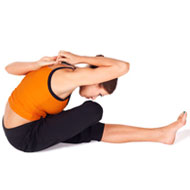- Aromatherapy (36)
- Benefits of Yoga (282)
- Home Remedies (1087)
- massage therapy (9)
- Preventive Therapy (135)
- Running (41)
- Skin Care (15)
- Stress Relief (25)
- Stretching (5)
- walking (33)
- Womens Health (14)
- Yoga Benefits for Pregnant Women (16)
- Yoga Benefits for Students (3)
- Yoga for Children (11)
- Yoga for Holistic Living (37)
- Yoga for Midlife Crisis (3)
- Yoga for Senior Citizens (2)
- Yoga for the Workplace (1)
- Yoga Health Tips (185)
- Yoga Practice during Menstruation (5)
What Is More Helpful Between Yoga and Progressive Muscular Relaxation Techniques?

Certainly yoga. There are two schools of thought regarding over all good health. One lays importance on physical well being in order to ensure it, whereas the other advocates that it is the mind which is most powerful, and controlling it helps and ensures physical well being as well. Yoga is an integrated science which ensures not only physical fitness, but also mental and spiritual well being through physical exercises, breath control, meditation and Ayurveda, the science of herbs, diet and spirituality. It is now accepted and acknowledged to be very effective by the modern science of healing.
Muscular relaxation technique is mainly used to counter stress disorders. It is a method to relax tense muscles, which in turn helps to relax the mind. It reduces anxiety, stress and panic attacks. In this method, each set of muscles are alternately made taut or tense and then relaxed. One starts with those of the lowest limbs, that is, the feet and progressively reaches those of the face. This is generally accompanied by breathing exercises and imagery. It is known to be particularly effective when one needs to stay alert, clear headed and perform under pressure.
Yoga deals with this mental problem in a three pronged manner which is a lot more effective and long lasting. It first makes you aware and accept that you are stressed or in panic. Yoga has a very positive effect on the nervous system. It helps you to master your psychological response to a stressful situation which in turn helps you to face it in a positive, calm and effective manner.
There are a variety of asanas to deal with the various stresses induced disorders such as:
- Fear: Padmasana lotus posture), Siddhasana (perfect posture), Virabhadrasana (warrior posture), Matsyasana (fish posture), Sarvangasana (shoulder stand), meditation.
- Tension, Loss Of Confidence And Concentration: Meditation, Sirshasana (standing on one's head), Sarvangasana, Bhujangasana (cobra posture), Matsyasana (fish posture), Trikonasana (triangle posture), padmasana (lotus posture), Shavasana (corpse posture).
- Frustration: Padmasana (lotus posture), Shavasana (corpse posture), Nadi Shodhana, meditation.
- Insomnia: Shavasana (corpse posture), Halasana (plough posture), Ardha Matsyasana (semi fish posture), Trikonasana (triangle posture), meditation.
There are various types of pranayama or breath regulating exercises, the most effective among which is Nadi Shodhana. It is a method to unblock the subtle nerve channels through which the life force or `prana' flows. This helps in not only relieving stress, but also in energizing the entire system. And then there is meditation. There are countless methods of meditation. Some of the most authentic and beneficial ones are Kriya yoga, Sahaj Samadhi, Transcendental Meditation, Sudarshan Kriya, Zen meditation, Buddhist meditation and others.
A suitable and correct diet and use of appropriate herbs goes a long way in countering stress.
- RSS Feeds -
- All posts
- All comments
- Deep Breathing & Coughing Exercise Practicing deep breathing exercises is important in the development of health...
- Yoga Meditation Relaxation Meditation and relaxation methods that teach us to attain the level of Dhyan...
- Varieties of Massage Techniques Therapeutic massage is an ideal way to deal with stress and health disorders ...
- Counseling For A Better Living In this rush hour and hectic life every one is looking for peace and tranquil...